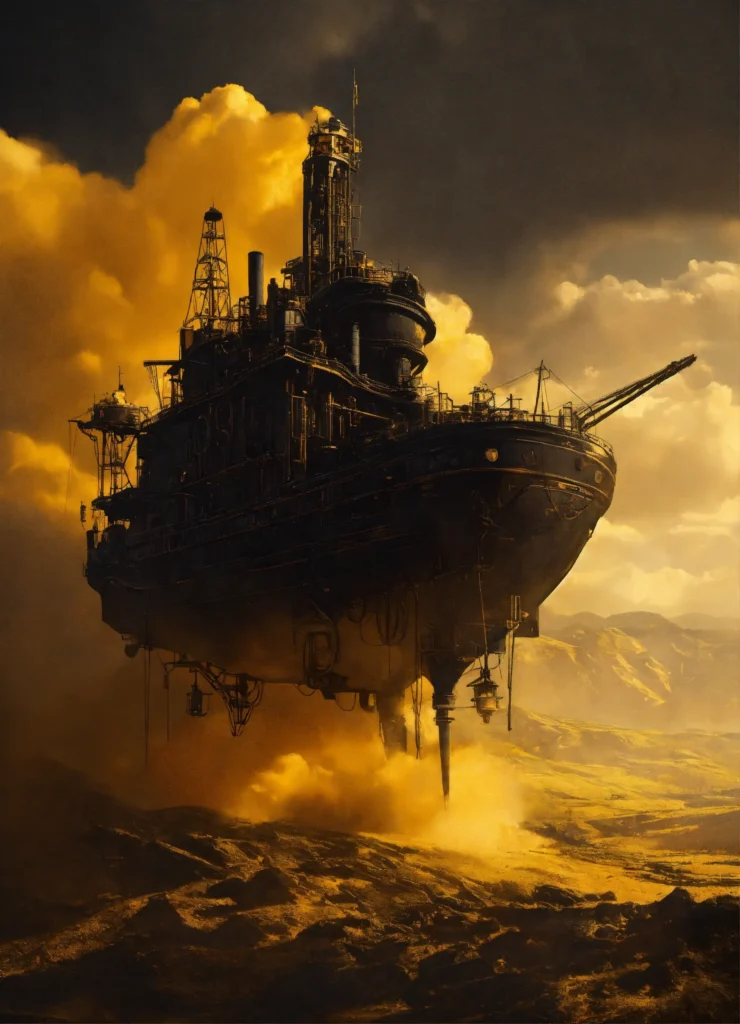
In the year 3824, the world had transformed beyond recognition. Cities floated among the clouds, infused with vibrant colors and pulsating energy. The ground below was a distant memory, a relic of a past that was both romanticized and forgotten. It was an era where technology and nature coexisted harmoniously, where the air was thick with the scent of exotic flora, and where the sky was a realm of endless possibilities.
Amidst this backdrop of innovation and ambition, a man named Nuru Kweku had a vision. He was a dreamer, a thinker, and a creator. Nuru grew up listening to stories of the ancient world when flying ships were mere fantasies, a childlike wonder that never left him. Now, as an adult, he believed it was time to bring those fantasies to life. He wanted to revolutionize transportation, to create a fleet of flying ships that would traverse the skies with grace and efficiency.
With a heart full of dreams and pockets that echoed with potential, Nuru founded his startup, Skyward Innovations. His office was a sleek glass structure suspended between two floating islands, adorned with holographic displays and interactive blueprints of his designs. Nuru poured every ounce of his soul into the project, envisioning a world where flying ships were accessible to everyone, not just the elite.
He assembled a diverse team of engineers, designers, and dreamers. Among them was Amina, a brilliant aeronautical engineer with roots in the ancient wisdom of her ancestors. She infused their designs with biomimicry, drawing inspiration from the majestic birds that soared gracefully through the skies. There was also Tunde, a marketing guru with an eye for storytelling, who narrated their vision to the world, painting vivid pictures of a future where anyone could own a flying ship.
However, as the months passed, reality began to claw at the edges of Nuru’s dream. The costs of production spiraled far beyond their initial estimates. The materials they needed were rare and expensive, harvested from the depths of the cloud forests. Each prototype they built faced issues, from energy inefficiencies to aerodynamic failures. Every setback felt like a dagger to Nuru’s heart, but he refused to give in. He believed in the power of persistence and innovation.
In the bustling metropolis of New Kinshasa, where the air buzzed with excitement and the sky shimmered with the glow of countless flying vessels, Nuru pitched his ideas to investors. He waved his hands passionately, painting a picture of a future where flying ships were as commonplace as cars—where families could take vacations across the skies, where businesses could connect with clients in the blink of an eye. But each pitch met with skepticism. The investors, cautious and practical, sought immediate returns. They were not ready to risk their fortunes on something that felt like a relic of the past.
“Your vision is beautiful, Nuru,†one investor said, the lines on his face etched with the concerns of experience. “But we live in a world of instant gratification. People want flying taxis, not flying ships. The market is saturated with alternatives. Your dream is noble, but it’s not feasible.â€
Crushed but undeterred, Nuru returned to his team with a renewed sense of purpose. He believed that innovation could overcome any obstacle. They worked tirelessly, bonding over long nights filled with coffee and laughter, brainstorming ways to cut costs and optimize designs. Amina suggested rethinking the propulsion system, while Tunde proposed a crowdfunding campaign to involve the community and generate buzz.
As the campaign launched, the initial response was overwhelmingly positive. People resonated with Nuru’s vision, sharing nostalgic stories of the past. They longed for a connection to a time when the skies were the ultimate frontier, a space of adventure and exploration. Crowdfunding soon gathered a loyal community, and Nuru felt a flicker of hope reignite within him.
However, hope turned to despair as the reality of logistics set in. Manufacturing costs continued to escalate, and partnerships with suppliers faltered. A critical prototype was delayed, and the once-enthusiastic community began to waver. Complaints flooded in about the lack of updates, and soon the whispers of doubt grew louder.
“Is this project even viable?†some questioned. “Maybe we should invest in something more practical.â€
Faced with dwindling support and increasing pressure, Nuru was forced to confront the harsh truth—his dream was not materializing as he had envisioned. The final blow came when a rival company, with more resources and a more streamlined vision, unveiled their own flying ship. It was sleek, efficient, and affordable, and it captured the attention of the very investors Nuru had sought.
With the weight of failure heavy upon him, Nuru gathered his team. They sat in the glass office overlooking the vast expanse of clouds, the vibrant city alive with the hum of flying vessels. He could see the flicker of disappointment in their eyes, the quiet resignation of dreams unrealized.
“Nuru, we tried our best,†Amina said gently. “We pushed the boundaries of innovation, but sometimes the world is not ready for what we envision.â€
Nuru nodded, tears welling in his eyes. “I thought we could change the world. I thought we could bring back the magic of the skies.â€
As they dismantled their prototypes and packed away their dreams, Nuru felt a mixture of sadness and enlightenment. He realized that sometimes, the journey itself was more valuable than the destination. They had created something beautiful, a tapestry of hope woven from the threads of their dreams, and that could not be taken away.
Though Skyward Innovations did not succeed, the spirit of innovation did not die with it. Nuru learned from the experience, growing as a leader, a creator, and a dreamer. He took with him the lessons of perseverance, the importance of community, and the understanding that failure was merely a step on the path toward future success.
In the years that followed, Nuru would find himself again, not as the owner of a startup but as a mentor to young innovators, guiding them through the tumultuous skies of entrepreneurship. He spoke of the beauty of dreams, the necessity of resilience, and the importance of adapting to the ever-changing landscape of possibility.
And as he stood on the edge of one of the floating islands, watching the vibrant vessels soar above, he could feel the pulsing energy of the skies—a reminder that the future was still a canvas waiting to be painted, and he held the brush.
Source: Read MoreÂ



